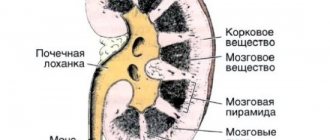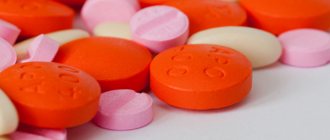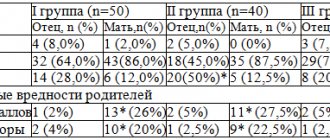DIAGNOSIS AND PRINCIPLES OF TREATMENT OF CHRONIC RENAL FAILURE
The communication presents current diagnostic methods in chronic renal failure (CRF), outlines principles of its treatment. Great emphasis is laid on the importance of early medical treatment of CRF, whose main components are low-protein diets and hypertension control. The paper lists indications for dialysis, outlines principles of choice of its procedure, describes approaches to treating and preventing dyalisis-induced complications.
A.Yu.Nikolaev, N.L.Lifshits, Yu.S.Milovanov Problem Laboratory of Nephrology (Head - Corresponding Member of the Russian Academy of Medical Sciences I.E. Tareeva) MMA named after. I.M.Sechenova A.Yu.Nikolayev, NLLifshits, Yu.S.Milovanov Task Force Laboratory of Nephrology, (Head is I.Ye.Tareyeva, Corresponding Member of the Russian Academy of Medical Sciences), IMSechenov Moscow Medical Academy
X
chronic renal failure (CRF) is a symptom complex caused by the irreversible gradual death of nephrons due to primary or secondary chronic progressive kidney disease.
Prevalence and causes of chronic renal failure
The incidence of chronic renal failure varies in different countries (ranging from 100-600 per 1 million adults) and increases with age. If in children chronic renal failure is caused mainly by congenital and hereditary nephropathies, then in adults it is caused by bright glomerulonephritis and chronic pyelonephritis. In old and senile age, among the causes of chronic renal failure, the most important role is played by diabetes mellitus, gout, hypertension, atherosclerosis, obstructive urological and oncological diseases, and drug-induced kidney damage. Thus, among patients with chronic renal failure undergoing chronic dialysis treatment in the USA and Western Europe, 20-25% are patients with diabetic nephropathy. In African and Asian countries, the main causes of chronic renal failure include malarial, schistosome nephropathy and HIV nephropathy.
Clinical manifestations of chronic renal failure
In a patient with chronic renal failure, before other symptoms, complaints of decreased appetite, dryness and unpleasant taste in the mouth, nausea, and heaviness in the epigastrium are noted. Polyuria, nocturia, fatigue, chilliness, sleep inversion, skin itching, tonic cramps of the calf muscles are typical. In severe hypertensive syndrome, headaches, complications from the heart, cerebral vessels and fundus of the eye are often associated with decreased vision, up to complete blindness. Upon examination, the peculiar yellowish pallor of the skin attracts attention. The skin is dry (patients do not sweat), its turgor is reduced, hemorrhages and scratch marks are noted. Blood pressure (BP) is usually elevated. Overall muscle mass is often reduced. Characterized by frequent nosebleeds, puffiness of the face, urinary odor from the mouth (with advanced uremia). Patients are lethargic, apathetic, slow in moving and answering questions. In the terminal stage of uremia, severe overhydration (anasarca, interstitial pulmonary edema, acute left ventricular failure, cerebral edema), decompensated metabolic acidosis (periodic Kussmaul breathing), critical hyperkalemia, pericarditis, and a soporous state developing into uremic coma develop.
Diagnosis of chronic renal failure
Early diagnosis of chronic renal failure often causes difficulties. On the one hand, many years of asymptomatic chronic renal failure are often observed, especially characteristic of chronic pyelonephritis, latent nephritis, and polycystic disease. On the other hand, due to the polymorphism of lesions of internal organs in advanced chronic renal failure, its nonspecific “masks” may come to the fore: anemic, hypertensive, asthenic, gouty, osteopathic. The presence of persistent normochromic anemia in a patient in combination with polyuria and arterial hypertension should be alarming regarding chronic renal failure. However, early diagnosis of chronic renal failure is based primarily on laboratory and biochemical methods. It is informative and reliable to determine the maximum relative density (osmolarity) of urine, the value of glomerular filtration (GF) and the level of creatinine (Cr) in the blood serum. A decrease in the maximum relative density of urine below 1018 in the Zimnitsky test, along with a decrease in CF in the Rehberg test to a level of less than 60 ml/min, indicates the initial stage of chronic renal failure. Azotemia (Kr>0.12 mmol/l) occurs at a later stage - when EF decreases to 40 - 30 ml/min. In favor of chronic renal failure in terms of its differentiation from acute renal failure, data from a long “renal history”, disturbances in phosphorus-calcium metabolism, as well as a decrease in kidney size speak. Depending on the stage of chronic renal failure, conservative and active treatment is used.
Conservative treatment of chronic renal failure
The objectives of conservative therapy are to slow down the rate of progression of chronic renal failure, to eliminate factors that aggravate its course (intercurrent infections, water and electrolyte disturbances, hypovolemia, nephrotoxicity of medications), as well as to correct hormonal and metabolic disorders characteristic of uremia (anemia, hyperphosphatemia, hyperlipidemia). Particularly important are adherence to a low protein diet (LPD) and control of renal hypertension. Compliance with the MBD reduces the severity of azotemia, improves phosphorus-calcium metabolism, and promotes longer-term preservation of residual renal function. In the initial stage of chronic renal failure, protein consumption is limited to 0.7 - 0.8 g per 1 kg of body weight. With more severe chronic renal failure (blood blood 0.35 - 0.5 mmol/l, urea 16 - 20 mmol/l), switch to diet 7b with protein limitation to 0.5 g/kg per day, potassium to 2.7 g/ day, phosphorus up to 700 mg/day. In case of advanced chronic renal failure (Cr>0.5 mmol/l, urea more than 20 mmol/l, EF 10 - 25 ml/min), diet 7a (Giovanetti type) with a sharp restriction of protein (0.25 - 0.3 g/min) is recommended kg per day), potassium (up to 1.6 g/day), phosphorus (up to 400 mg/day). At the same time, at least half of the daily amount of protein should be complete protein (cottage cheese, eggs, meat). Due to lipid metabolism disorders characteristic of chronic renal failure, leading to early atherosclerosis with a high risk of developing coronary artery disease and cerebrovascular pathology, enrichment of MBD with polyunsaturated fatty acids (vegetable oil, seafood, fish oil) is useful. The caloric content of MBD should not be lower than 2100 - 2200 kcal/day; it is optimal to maintain it at the level of 3000 kcal/day, which is achieved by increasing the content of carbohydrates and fats. The combination of MBD with preparations of essential keto acids (ketosteril, Germany, etc.) reduces the risk of developing a negative nitrogen balance and improves the utilization of urea nitrogen in the patient’s body. The effectiveness of MBD is evidenced by a decrease in the symptoms of uremic intoxication, a decrease in the level of urea and blood phosphates in the absence of weight loss, hypoalbuminemia, hyperkalemia and stable levels of pH and serum bicarbonates. Arterial hypertension, one of the main factors accelerating the progression of chronic renal failure, is in most cases associated with sodium and water retention (volume-sodium dependent), therefore, individual recommendations for compliance with the water-salt regime, determined taking into account the severity of polyuria and daily excretion, are extremely important for treatment sodium in urine. Removal of excess sodium and fluid is also achieved by prescribing saluretics (furosemide, bumetanide); Ethacrynic acid is used with caution (due to the risk of ototoxicity). The use of potassium-sparing diuretics (veroshpiron, triampur, amiloride) in patients with chronic renal failure is not recommended. Thiazide diuretics (hypothiazide, chlorthalidone, hygroton) are contraindicated. Treatment of arterial hypertension, which in patients with chronic renal failure should be long-term and continuous, should begin with small doses with a gradual increase to a therapeutic level, since a sharp decrease in blood pressure can lead to hypovolemia and aggravate chronic renal failure (a single-stage decrease in blood pressure from the initial level should not exceed 25% ). The level of blood pressure at which renal blood flow is maintained in patients with chronic renal failure, sufficient for the maximum possible EF, usually 10–15 mmR. Art. above the age norm. However, recently, therefore, achieving normal blood pressure has been recognized as optimal. The most suitable sympatholytics for the treatment of hypertension in patients with chronic renal failure are dopegit and clonidine, which, when used systematically, combine well with saluretics. Due to its slow elimination, the dose of dopegyt should be reduced by 1.5–2 times. Peripheral arteriolodilators (minoxidil, hydralazine), combined with saluretics and small doses of beta-blockers, are characterized by a stronger hypotensive effect and a beneficial effect on renal blood flow. Calcium ion antagonists (nifedipine, nicardipine, isradipine, diltiazem, etc.), which do not cause sodium and water retention or a decrease in renal blood flow, do not activate the RAAS and therefore can be used for chronic renal failure both for monotherapy and in combinations. For more severe renin-dependent hypertension, patients with chronic renal failure are prescribed drugs that reduce renin secretion: large doses of beta-blockers (obzidan 160–400 mg/day, Sectral 400–600 mg/day), an alpha- and beta-adrenergic receptor blocker (labetalol). When hypertension is combined with heart failure, beta blockers should be used with caution in combination with saluretics, nitrates, and cardiac glycosides. The dose of cardiac glycosides is reduced taking into account the pharmacodynamics of chronic renal failure and potassium levels to 50–70% of the therapeutic value. In cases of refractoriness to other antihypertensive drugs (uncontrolled renal hypertension), angiotensin-converting enzyme inhibitors (ACE) are used (captopril, enalapril, ramipril, lisinopril), used as monotherapy or in combination with saluretics, beta-blockers, calcium antagonists. ACE inhibitors and some calcium antagonists (verapamil, diltiazem) have nephroprotective properties, the ability to reduce intraglomerular hypertension, proteinuria and significantly slow down the rate of progression of chronic renal failure, and therefore they are singled out as first-choice drugs in patients with chronic renal failure, especially with diabetic nephropathy from the very early stages. stages. Recently, new promising drugs from the group of tissue receptor blockers for angiotensin II (losartan, irbesartan) have appeared, free from a number of side effects of ACE inhibitors. To relieve hypertensive crises in patients with chronic renal failure, sublingual clonidine, Corinfar or Capoten or parenteral administration of Lasix, isoptin, minoxidil or peripheral vasodilators (diazoxide, sodium nitroprusside) are recommended. The combination of drugs with different mechanisms of antihypertensive action makes it possible to achieve an effect without the use of high doses of medications. Recommended combinations: ACE inhibitor + saluretic + beta blocker; calcium antagonist + beta blocker + sympatholytic with salt restriction, etc.
Active treatment of chronic renal failure
Currently, three methods of active treatment for uremia are used: chronic hemodialysis (HD), chronic peritoneal dialysis (PD), and kidney transplantation. The problems of kidney transplantation are beyond the scope of this publication. Hemodialysis (HD)
carried out by connecting the arteriovenous fistula to the “artificial kidney” monitor.
Nitrogenous wastes and electrolytes diffuse through a synthetic semi-permeable membrane, and water is removed by hydrostatic pressure from the blood (ultrafiltration). Standard HD is performed in intermittent mode 2–3 times a week (dialysis time 12–15 hours per week) using an acetate or bicarbonate buffer. Peritoneal dialysis (PD)
is performed by injecting a dialysate solution into the abdominal cavity through a chronic peritoneal catheter. In this case, the role of a semi-permeable membrane that eliminates nitrogenous wastes and electrolytes is played by the peritoneal mesothelium. Water removal (ultrafiltration) occurs under the influence of an osmotic pressure gradient through the use of solutions with a high concentration of glucose (dextrose).
Indications for starting dialysis treatment for chronic renal failure
Patients of senile and childhood age, patients with severe diabetes, coronary artery disease, patients with nephrotic syndrome, cachexia are subject to early enrollment for dialysis treatment (at a blood blood level of less than 0.6 - 0.7 mmol/l, EF more than 10 - 15 ml/min). , uncontrolled hypertension, chronic infections, uremic polyneuropathy, overhydration, hyperkalemia, decompensated metabolic acidosis. In other cases, dialysis treatment should begin in the terminal stage of chronic renal failure (with an increase in the level of Kr more than 0.7 - 0.9 mmol/l and a decrease in EF below 10 ml/min) after using all the possibilities of conservative therapy. For the success of active treatment of uremia, the level of psychological adaptation of the patient to treatment, the correct choice of the dialysis method and effective dialysis regimen, and the tolerance of the buffer are important. So, bicarbonate HD
indicated for acetate intolerance (impaired metabolism due to muscle deficiency, cachexia), severe metabolic acidosis, diabetes mellitus, arterial hypotension, chronic heart failure, obstructive pulmonary diseases.
With standard HD, excess water, sodium, potassium and nitrogenous wastes are removed rapidly during the next session. Complications of such a non-physiological intermittent regime include: a rapid decrease in the level of urea and sodium in the blood with the development of hypoosmolar syndrome, a decrease in circulating blood volume (CBV) with syndialytic hypotension, acute impairment of coronary and cerebral blood supply, a decrease in the level of potassium in the blood with cardiac arrhythmias. In case of hemodynamic instability during standard HD, “low-speed” HD using large-area low-permeability membranes may be useful. A session of such HD lasts 1.5 - 2 times longer than a standard session (dialysis time 20 - 24 hours per week), which provides better control of hemodynamics, blood volume, and osmotic homeostasis. If there is no effect, the use of bicarbonate computerized HD on high-permeability membranes (HPM), hemodiafiltration, or transfer to PD is indicated. HD on the ILM and hemodiafiltration are based on the principles of automatic control over changes in blood volume, plasma osmolarity and ultrafiltration rate. Thus, a dangerous decrease in plasma osmolarity, a tendency to hypovolemia, and collapse on HD can be corrected by increasing the sodium concentration in the dialysate solution (sodium profiling), reducing the ultrafiltration rate, and increasing the rate of intravenous infusion of the replacement solution. HD on the ILM is indicated for severe uremic intoxication, anuria, hypercatabolic conditions, infectious complications, cachexia, critical overhydration, uncontrolled hypertension, heart failure, syndialytic hypotension, hyperphosphatemia. If it is impossible to form a reliable arteriovenous fistula, treatment of chronic renal failure is realistic only with the help of PD. Transfer to PD is also advisable in cases where the patient does not tolerate standard HD well, and HD on the ILM cannot be carried out. Thus, patients with chronic renal failure, suffering from severe coronary artery disease, chronic heart failure, and arterial hypotension, adapt better to PD. Finally, carriers of hepatitis B, C, and AIDS viruses, patients with chronic renal failure, on PD are less dangerous to others than virus carriers on HD. Continuous ambulatory peritoneal dialysis (CAPD) has found widespread use as home dialysis. With CAPD, the dialysate solution remains in the abdominal cavity constantly; it is changed at home by the patient himself 4–5 times a day. The procedure for replacing a used solution with a fresh one takes a trained patient 10-20 minutes. In this case, 7–9 liters of dialysate solution are replaced per day. The decisive condition for the effectiveness of dialysis treatment is the optimization of its dose.
Taking into account the severity of azotemia, hyperhydration, and the amount of residual renal function, the optimal regimen (dialysis dose) is selected: total urea clearance and ultrafiltration intensity.
With an unreasonable reduction in dialysis time, patient non-compliance with the water-salt regime, hypercatabolism, loss of residual renal function, an extremely unfavorable prognostic syndrome of underdialysis is formed.
It is characterized by hyperhydration that persists during dialysis treatment (volume-sodium-dependent hypertension with congestive heart failure, repeated pulmonary edema, ascites), relapses of pericarditis, and progressive polyneuropathy.
It is important to emphasize that hypertension during HD can be a manifestation of chronic renal failure, a symptom of underdialysis, a complication of drug therapy and therefore requires a differentiated approach to treatment. If volume-sodium-dependent hypertension as part of the underdialysis syndrome must be corrected by increasing the dialysis time and tightening the interdialytic water-salt regime, then in the treatment of renin-dependent, uncontrolled HD hypertension, the antihypertensive drugs mentioned above, as well as surgical methods, occupy an important place. Surgical treatment is required for renal artery stenosis, parathyroid adenoma, and adenocarcinoma in a wrinkled kidney cyst. Finally, for drug-induced hypertension (steroidal, sandimmune, erythropoietin), a dose reduction or temporary withdrawal of appropriate medications is required. Complications of dialysis treatment
can also determine the prognosis and quality of life in patients with chronic renal failure.
The problem of infectious complications is extremely relevant, the prevalence of which is explained by uremic immunodeficiency and the ease of infection (parenteral, intraperitoneal) during the dialysis procedure. Viral carriage (HBV, HCV) and bacterial carriage (Staphylococcus aureus) are detected in 40–50% of patients on dialysis. Acute infectious complications lead to death in 15–20% of patients on HD and CAPD. In HD patients, the most common infectious complications include acute viral hepatitis (HBV, HCV), and the most dangerous are pneumonia, shunt sepsis with acute infective endocarditis, and tuberculosis. The prevalence of tuberculosis in patients on HD is 7–10 times higher than in other groups of patients, and mortality from it reaches 40%. A sluggish gram-negative urinary tract infection is often associated with infection of cysts in shriveled kidneys, which in weakened patients can lead to pyonephrosis, perirenal abscess, and urosepsis. A typical infectious complication of CAPD is peritonitis. Side effects of drugs (overdose with general toxic and nephrotoxic effects) are observed in patients on dialysis especially often due to the difficulties of selecting an effective dose in conditions of severely impaired pharmacodynamics of drugs in chronic renal failure. When choosing an antibiotic, it is important to know not only the main route of its elimination (kidney or liver), but also the degree of its loss through the dialysis membrane. Endocrine and metabolic manifestations of chronic renal failure,
which are not corrected or not completely controlled by effective dialysis therapy, have a significant impact on the medical rehabilitation and survival of patients on dialysis. The applied complex of hormonal replacement therapy makes it possible to correct renal anemia (erythropoietin preparations), uremic hyperparathyroidism (vitamin D3 metabolites). At the same time, the interpretation of dialysis osteopathy is ambiguous. Drugs successfully used for hyperparathyroid osteodystrophy - metabolites of vitamin D3 - are contraindicated in osteomalacia as part of chronic aluminum intoxication, when complexones (desferal) are required. Progressive osteoarthropathy in patients with dialysis (b2-microglobulin) amyloidosis goes into remission only after successful kidney transplantation. IHD remains one of the most common causes of disability and long-term mortality in HD patients. Risk factors for the rapid progression of coronary atherosclerosis in chronic renal failure, along with hypertension, hyperparathyroidism, anemia and left ventricular hypertrophy, include atherogenic hyperlipidemia, detected already at the early stage of chronic renal failure. To prevent coronary artery disease, it is recommended to enrich the diet with polyunsaturated fatty acids (omega-3, omega-6), dietary cholesterol sorbents, as well as lipid-lowering drugs. However, individual selection of the dose of statins, fibrates, and nicotinic acid is necessary, taking into account the high risk of side effects of drugs in patients with chronic renal failure. Thus, the modern approach to the treatment of chronic renal failure involves the early start of conservative therapy. In the terminal stage of uremia, individually selected dialysis methods are used in combination with pathogenetic (replacement) therapy, and complications of HD and PD are also treated.
Literature:
1. V.M. Ermolenko. Chronic hemodialysis. M., 1982. 2. S. Klar, S. Massri Modern nephrology. M., 1884. 3. I. Ledebo Acetate hemodialysis versus bicarbonate. Lund, Sweden, 1990 4. V.M. Ermolenko Chronic renal failure. In the book. Nephrology, ed. I.E. Tareeva. M., 1995, vol. I, p. 322–79. 5. Treatment of chronic renal failure. Ed. S.I. Ryabova. St. Petersburg, 1997. 6. A.Yu. Nikolaev, S.V. Lashutin, P.V. Klepikov Comparison of various erythropoietin preparations for renal anemia. Wedge. pharm. ter. 1993, No. 3, p. 30–3. 7. I.E. Tareeva, A.Yu. Nikolaev, N.L. Lifshits. Diagnosis and conservative treatment of chronic renal failure. Methodical recommendations for doctors. M., 1993. 8. A.Yu. Nikolaev, N.L. Lifshits, V.M. Ermolenko Experience of long-term use of a low-protein diet for chronic renal failure. Ter. archive, 1994, No. 6, p. 45–51. 9. N.L. Lifshits, I.M. Kutyrina Features of the treatment of hypertension in chronic diffuse kidney diseases. Materia Medica 1995, no. 2, p. 39–50. 10. A.Yu. Nikolaev, N.L. Lifshitz Arterial hypertension in patients with end-stage renal failure. Urology and nephrol., 1996, No. 1, p. 10–3.
Drugs that dissolve stones:
The kidneys usually begin to cleanse after the liver has already been cleansed. But people who simultaneously suffer from urolithiasis and cholelithiasis sometimes carry out simultaneous cleansing of the liver and kidneys from stones. At least they think they are doing it...
Skepticism in this situation is justified: the fact is that phytolysin and other agents act to a small extent and have no effect at all on some types of stones. So, alas, it is not always possible to cleanse the kidneys of stones with them.
In general, people with existing stones should not cleanse the liver and kidneys, at least not on their own. You need to ask a doctor to evaluate the situation. Perhaps you do not need medications at all, but other methods: either simple observation, or serious treatment measures such as surgery.







